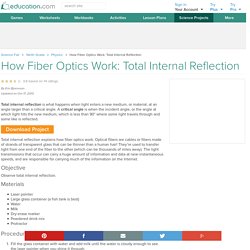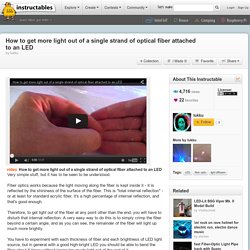

Adventures in Fiber Optics Kit. Fiber Optics Science Project Kit. How Fiber Optics Work: Total Internal Reflection. Total internal reflection is what happens when light enters a new medium, or material, at an angle larger than a critical angle.

A critical angle is when the incident angle, or the angle at which light hits the new medium, which is less than 90° where some light travels through and some like is reflected. Total internal reflection explains how fiber optics work. Optical fibers are cables or fibers made of strands of transparent glass that can be thinner than a human hair! They’re used to transfer light from one end of the fiber to the other (which can be thousands of miles away). The light transmissions that occur can carry a huge amount of information and data at near-instantaneous speeds, and are responsible for carrying much of the information on the Internet.
Observe total internal reflection. Fibre Optic Bracelet. Science Party: Fiber Optic Lamp. What's a Science Party without Physics, right?

To balance out all those other Chemistry experiments, Emily and I decided it would be fun to do a little electric circuitry. We also wanted to stage a fake dissection as a token Biology offering, but fabric frog innards were too time-consuming to sew, so we filed away that idea into the Maybe Another Party category of my brain. Before we settled on classic from-scratch circuitry, we considered the more trendy electric playthings now circulating the internet. Like electric playdough, for instance. We made it, it worked for us, but we couldn't see 16 kids "playing" with it and taking home something concrete at the end of the day to show for it. Just for info, electric circuitry is not the same is electronics. I like both, but I like electric circuitry more because I can see what's happening in the circuit.
Over the summer, Emily, with all that sunshiney time on her hands, started to dabble in electronics and simple computer programming. The Fiber Optic Store - Fiber Optic Hobby Lighting - Fiber Optic Filament Cable and Illuminators. Welcome visitors joining us from our sister site "Fiber Optic Projects.com" - you've been automatically redirected to our parent site "The Fiber Optic Store.com" Why was I redirected?

... and do you still have the product and projects available on The Fiber Optic Store.com? WHY: We are just a couple weeks away from the launch of our totally new website, and we needed to take the FiberOpticProjects site offline as we migrate some of the components over to the new site. PRODUCT: On this current site, you will find all of the products that were available to you on FiberOpticProjects.com. PROJECTS: Once the our new site launches, you'll have access once again to the various projects that were on FiberOpticProjects.com We appreciate your patience during this final phase. Thank You, Paul & Dave. How to make a fiber optic light diffuser with a dot of hot glue. How to attach fiber optic filament to an LED.
How to get more light out of a single strand of optical fiber attached to an LED. Video How to get more light out of a single strand of optical fiber attached to an LED Very simple stuff, but it has to be seen to be understood.

Fiber optics works because the light moving along the fiber is kept inside it - it is reflected by the shininess of the surface of the fiber. This is "total internal reflection" - or at least for standard acrylic fiber, it's a high percentage of internal reflection, and that's good enough. Therefore, to get light out of the fiber at any point other than the end, you will have to disturb that internal reflection.
A very easy way to do this is to simply crimp the fiber beyond a certain angle, and as you can see, the remainder of the fiber will light up much more brightly. You have to experiment with each thickness of fiber and each brightness of LED light source, but in general with a good high-bright LED you should be able to bend the fiber about 6 times without losing too much light out of the end of it.